What are the Most Common White Mushrooms in North Carolina?
Finding the most common white mushrooms in North Carolina or the South was not as easy as I thought. Some are edible, others are poisonous, and plenty of them don’t show appear often.
That’s why I created a list of the 10 Most Common White Mushrooms in North Carolina!
This ultimate guide will give you the most common white mushrooms in North Carolina, how to identify them, and even where to find them in North Carolina.
***DISCLAIMER***
This article is intended to be for entertainment purposes only. There are similar-looking types of mushrooms that can be poisonous to humans and animals.
Do not use this as a guide to forage mushrooms. Do not use this as a guide to prepare, cook, and eat mushrooms.
You should work with your local mycological society, foraging experts, and local community clubs for identifying, foraging, and potentially eating mushrooms. In addition, you should never forage mushrooms on your own or use this guide to assist you in foraging mushrooms.
Read THIS Before Identifying Common White Mushrooms in North Carolina
Knowing the type of mushroom growing in North Carolina or the South can be the difference between a fascinating hobby that can result in a nutritious and edible food source and a deadly toxin. Always make sure to work with your local city and gardening club before eating mushrooms found in the wild.
It is important to pay close attention to the following when picking or eliminating mushrooms in North Carolina:
- The size, including the cap, gills, scales, spores, and stem.
- The color, including the cap, gills, scales, spores, and stem.
- Location, both in the United States and in your yard
- Odor and even taste
And if you want to learn more about common white mushrooms that grow in North Carolina watch the below video!
10 Most Common White Mushrooms in North Carolina
#1. Fairy Ring Mushroom (Marasmius Oreades)


Specifications:
- The Fairy Ring Mushroom has a white, cream cap, white spores, narrow to broad white/brown gills, and thin stalks.
- This type of mushroom grows from late summer to early winter throughout the United States, including North Carolina.
- This is an interesting mushroom that animals love to eat and are nutritious for them.
- An interesting fact is that the fairy ring will form perfect circles where they grow, but this may change depending on the amount of foot traffic by humans or animals.
#2. Field Mushroom (Agaricus campestris)
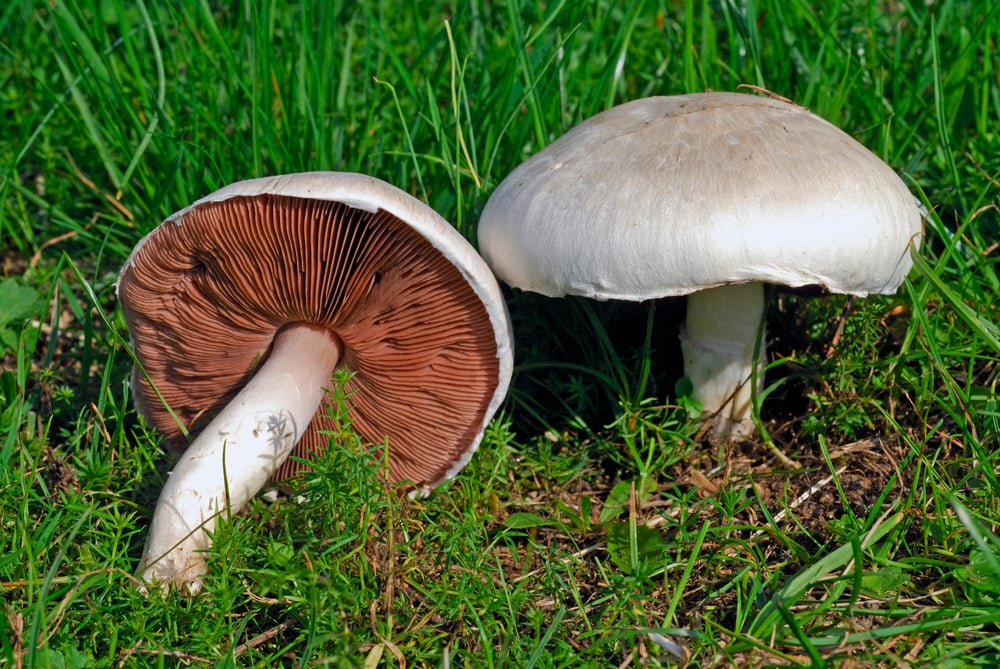

Specifications:
- The Field Mushroom has a white and pink cap, dark chocolate spores, narrow to broad white stalks that are brown, and deep pink and brown gills.
- This type of mushroom grows from late summer to early winter throughout the world, including North Carolina, Ireland, and Wales. It is also one of the most commonly eaten white mushrooms in the world by cows and goats.
- You can leave these mushrooms in your yard. They grow on dead vegetation and will not kill trees, live plants, etc.
- The Meadow Mushrooms sometimes can be confused for Field Mushrooms due to their white gills and spores, but should not be foraged or eaten!
#3. Dapperling Mushroom (Lepiota oreadiformis)
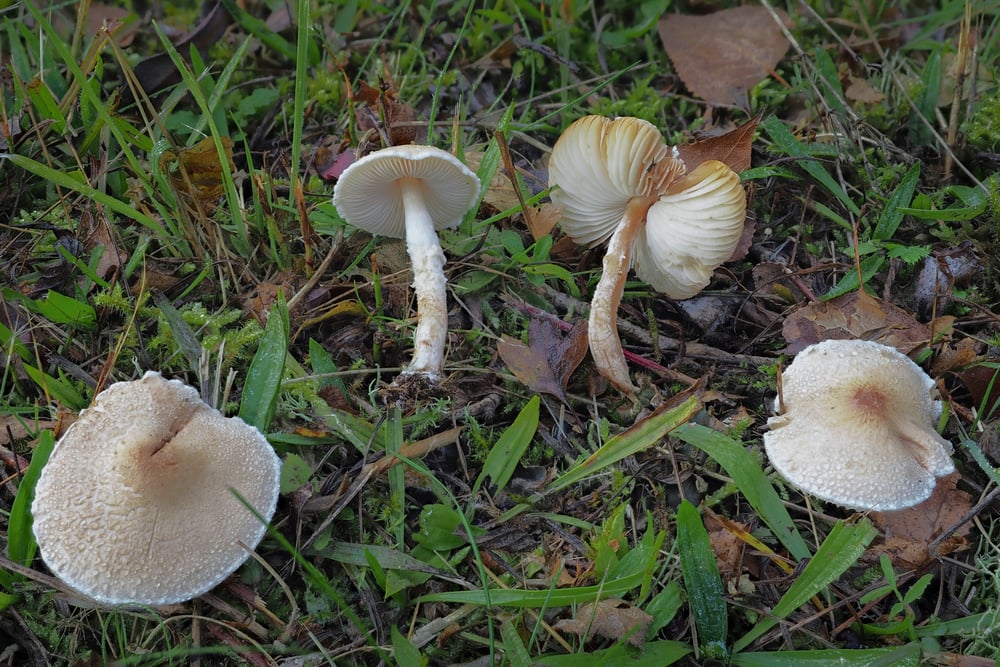

Specifications:
- The Dapperling Mushrooms has a white and cream cap, white spores, narrow white stalks, and white to cream gills.
- This type of mushroom grows from late summer to late fall throughout the world, including United States, Ireland, and Britain. This mushroom should not be consumed and is very toxic if consumed.
- While these mushrooms are toxic to humans and animals, they will not damage the environment around them. You can typically find this on sandy soil along coastlines and you may rarely find it on the outskirts of grasslands.
- This mushroom should not be consumed. This is generally considered inedible and toxic. Sometimes foragers can confuse this for edible mushrooms, but just consuming a few of these mushrooms can cause adverse side effects.
- The Dapperling Mushroom is one of the mushrooms on this list that you won’t see as often as others, but still can come upon quite often in North Carolina! It is best to leave it be and spend your time identifying other white mushrooms in North Carolina!
#4. Morels Mushrooms (Morchella esculenta)
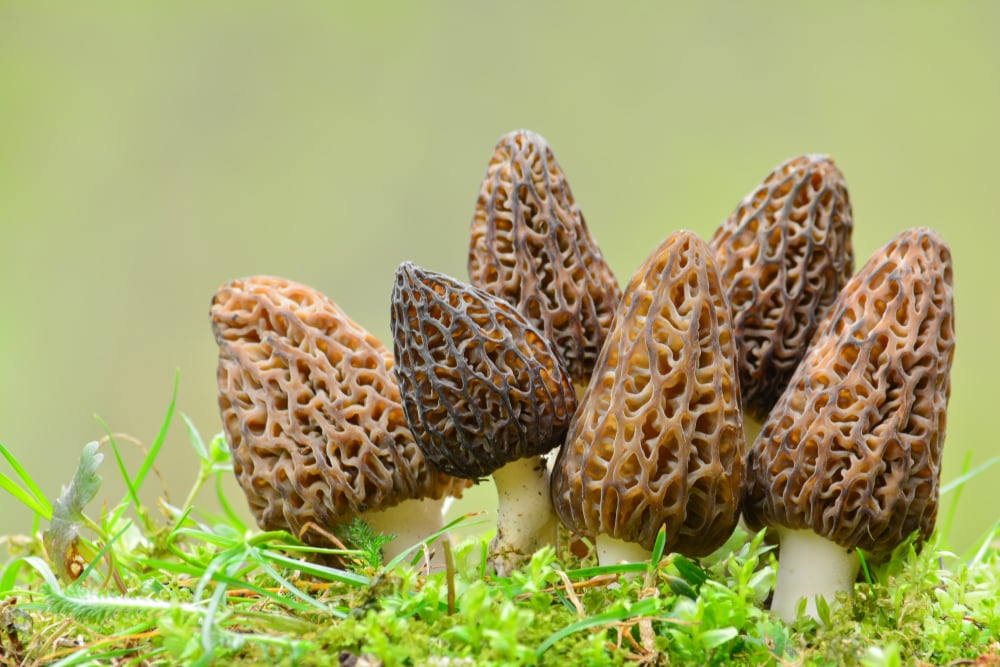

Specifications:
- The Morel Mushroom has a yellow and brown flesh orange cap, white spores, thick white or pale cream stalks, and brown gills.
- This type of mushroom grows from spring to early fall in the United States. While it can also be found in Ireland and Great Britain, it is much rarer. The Morel Mushroom is one of the most common white mushrooms in North Carolina that can be found and eaten.
- You can leave the Morel Mushroom and even pick them up. This mushroom is considered symbiotic with its environment and can be found under trees and sometimes on trees. They are considered a beneficial partner with trees and insects won’t harm them either!
- This mushroom should be consumed! This is considered when of the most sought-after mushrooms in North Carolina but should be noted that in large quantities it may cause a stomach ache.
- Did you know that the Morel Mushroom is one of the few mushrooms you can grow in your very own home?
#5. Haymaker Mushroom (Panaeolus foenisecii)
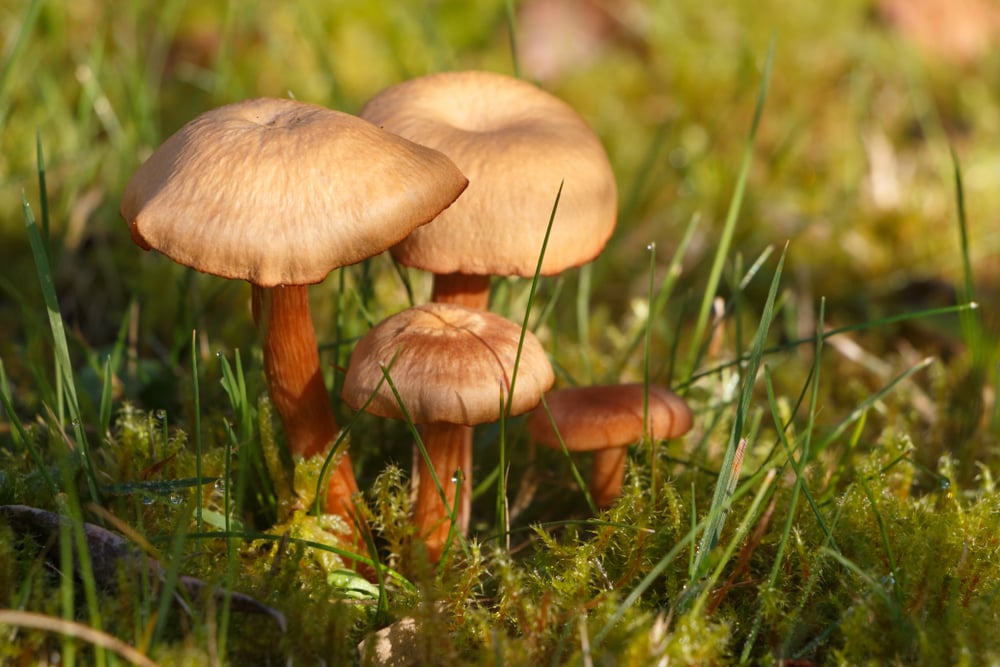

Specifications:
- The Haymaker Mushroom has a Brown cap, white spores, thin, small brown stalks, and brown gills.
- This type of mushroom grows from spring to early winter in North Carolina and the United States. It can also be found throughout the Northern Hemisphere of the world.
- The Haymaker Mushroom is the most common white mushroom in North Carolina. You can expect it whether you mow or fertilize your law. While it is not a parasite to your lawn or plants, it should be removed so that it isn’t foraged by children. You will find this mushroom in grassy areas!
- The Haymaker’s Mushroom is also known as the Mower’s Mushroom as this is a common white mushroom in North Carolina seen when mowing or tending to one’s lawn.
#6. Shaggy Inkcap (Coprinus comatus)
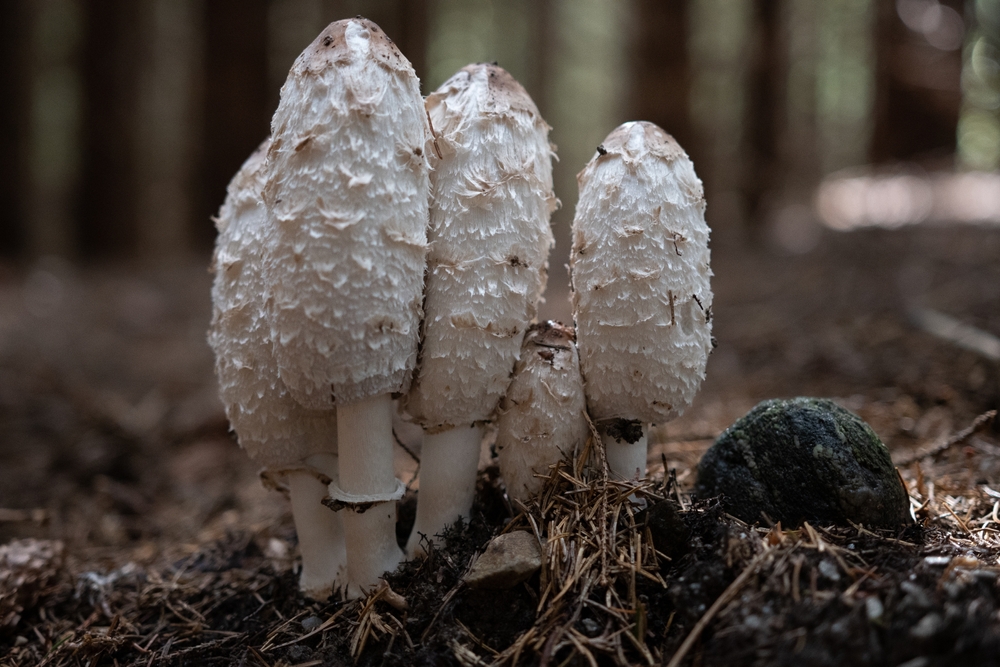

Specifications:
- The Shaggy Inkcap Mushroom has a white cap, white spores, thick, white stalks, and cream-white gills.
- This type of mushroom grows from spring to early winter in the United States, Ireland, Britain, and Southern Europe. This is an edible and nutritious mushroom that can be consumed.
- The Shaggy Inkcap Mushroom can be found in North Carolina, the United States, and throughout Southern Europe. You will find it in open woodlands and grassy lawns.
- This mushroom is very versatile, but should not be consumed.
#7. Destroying Angel Mushroom (Amanita virosa)
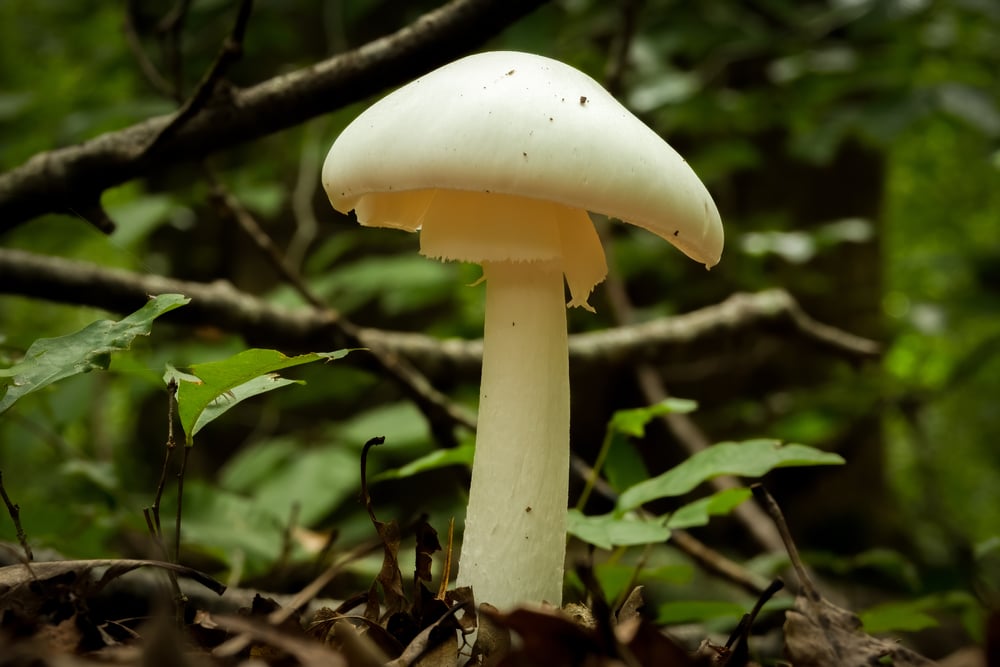

Specifications:
- The Destroying Angel Mushroom has a white cap, white spores, tall and thick white stems, , and white gills.
- This type of mushroom grows from summer to fall in the United States, Ireland, and Britain. No one or no animal will typically consume this type of mushroom as it is the deadliest common white mushroom on the planet.
- The Destroying Angel Mushroom can be found in yards in North Carolina and the United States. You will find it in grassy areas on the edge of wooded areas.
- This mushroom should not be consumed! It is the deadliest mushroom on the planet and can cause organ failure and even death.
- The Destroying Angel Mushroom is one of the most misidentified mushrooms by novice mushroom foragers. You should take extra precautions when foraging mushrooms.
#8. Puffball Mushroom (Lycoperdon perlatum)
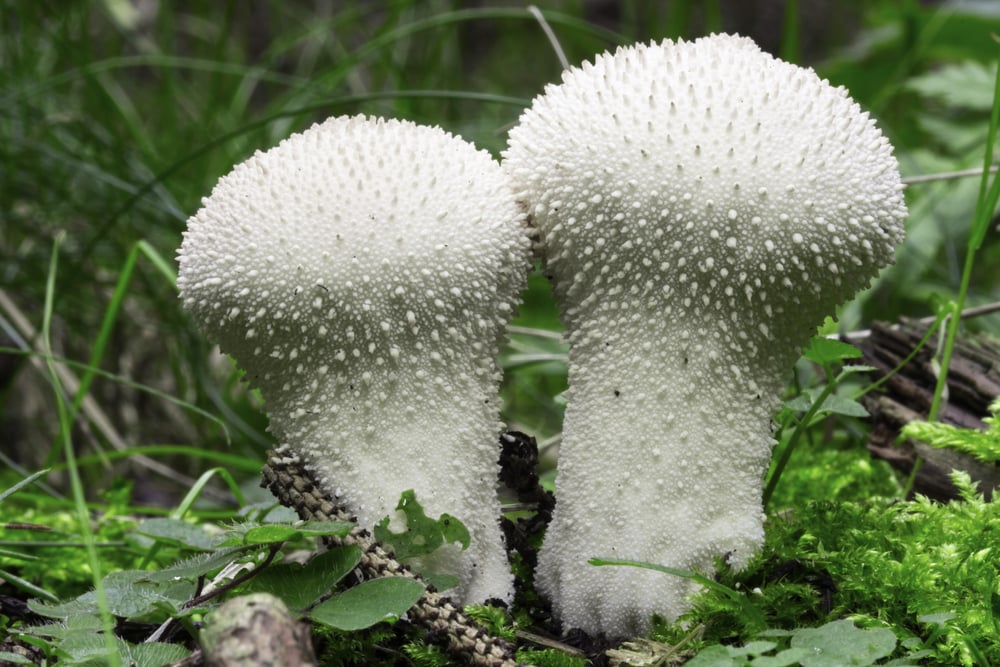

Specifications:
- The Puffball Mushroom has a white and cream cap, white spores, tall and thick white stems, and cream gills.
- This type of mushroom grows from summer to early winter in the United States, Ireland, and Britain. This isn’t a very popular type of mushroom.
- The Puffball Mushroom can be found in North Carolina and the United States. You will find them in woodlands, leaves, and even sandy areas.
- The Puffball Mushroom gets its name based on how it looks like a giant puffball when rain hits it or an animal or person rubs up against it!
#9. False Parasol (Chlorophyllum rhacodes)
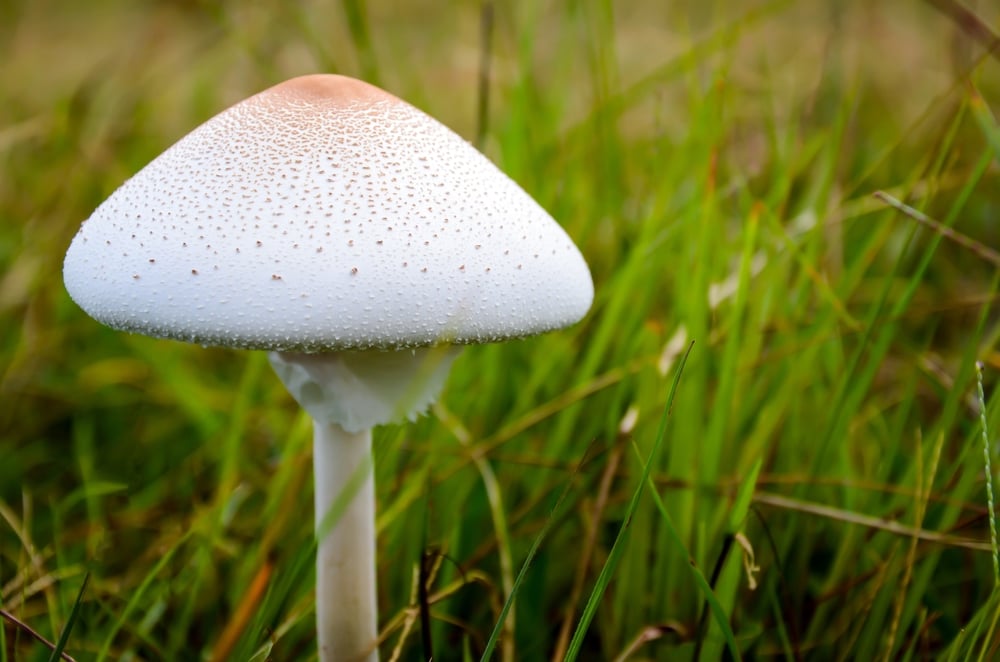

Specifications:
- The False Parasol Mushroom has a white and cream cap, white spores, tall and thick white and cream stems, and cream gills.
- This type of mushroom grows from summer to fall in the United States, Ireland, and Britain.
- The False Parasol Mushroom can be found in yards in North Carolina and the United States. You will find them in Woodland Areas and also in Humous-Rich Soil in Gardens.
- The False Parasol Mushroom is another mythical mushroom that can be found in European folklore and is known for its connection with fairies and fairy rings.
#10. Milkcap Mushroom (Lactarius subdulcis)
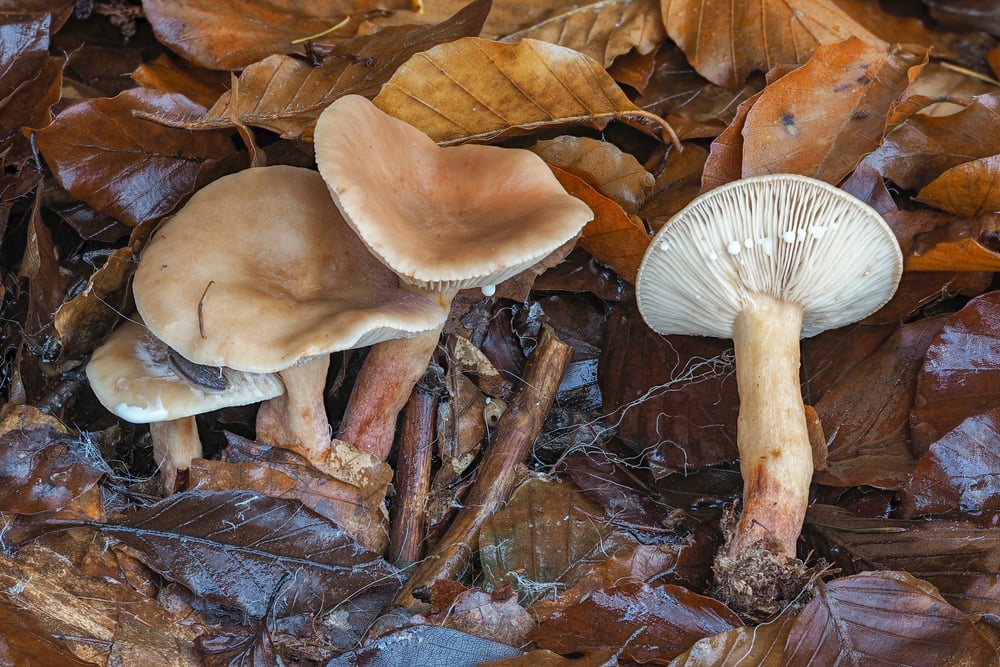

Specifications:
- The Milkcap Mushroom has a creamy white cap, white and brown spores, small and thin white cream stems, and white and brown gills.
- This type of mushroom grows from summer to winter in the United States, Ireland, and Britain.
- The Milkcap Mushroom can be found in yards in North Carolina and the United States. You will find them under hardwood trees.
- When the Milkcap Mushroom gills and cap are cut you’ll notice a creamy-white liquid.
Common Factors of the Most Common White Mushrooms in North Carolina

As a reminder, the below factors are common for the most common white mushrooms in North Carolina
- Most are parasitic to humans and should not be consumed.
- These mushrooms can be found throughout your yard, but most commonly on trees and in wet areas of your yard.
- Each mushroom on this list has a common fungus relative that it can be mistaken for. Leverage this guide to have the best chance of identifying common white mushrooms in North Carolina.
- Most mushrooms on this list will only grow a maximum height of 6 inches tall and 3 or 4 inches wide.
- A majority of the mushrooms on this list will have no smell to them.
And remember that you should pay attention to this guide, other local experts, and your local mushroom clubs before foraging. This can be the difference between a nutritious and delicious mushroom and a harmful and even deadly fungus.
If you want to learn about other mushrooms, chickens, vegetables, fruits, herbs, and bees check out thegardeningdad and search for the plant you want to grow in the upper right-hand corner.

